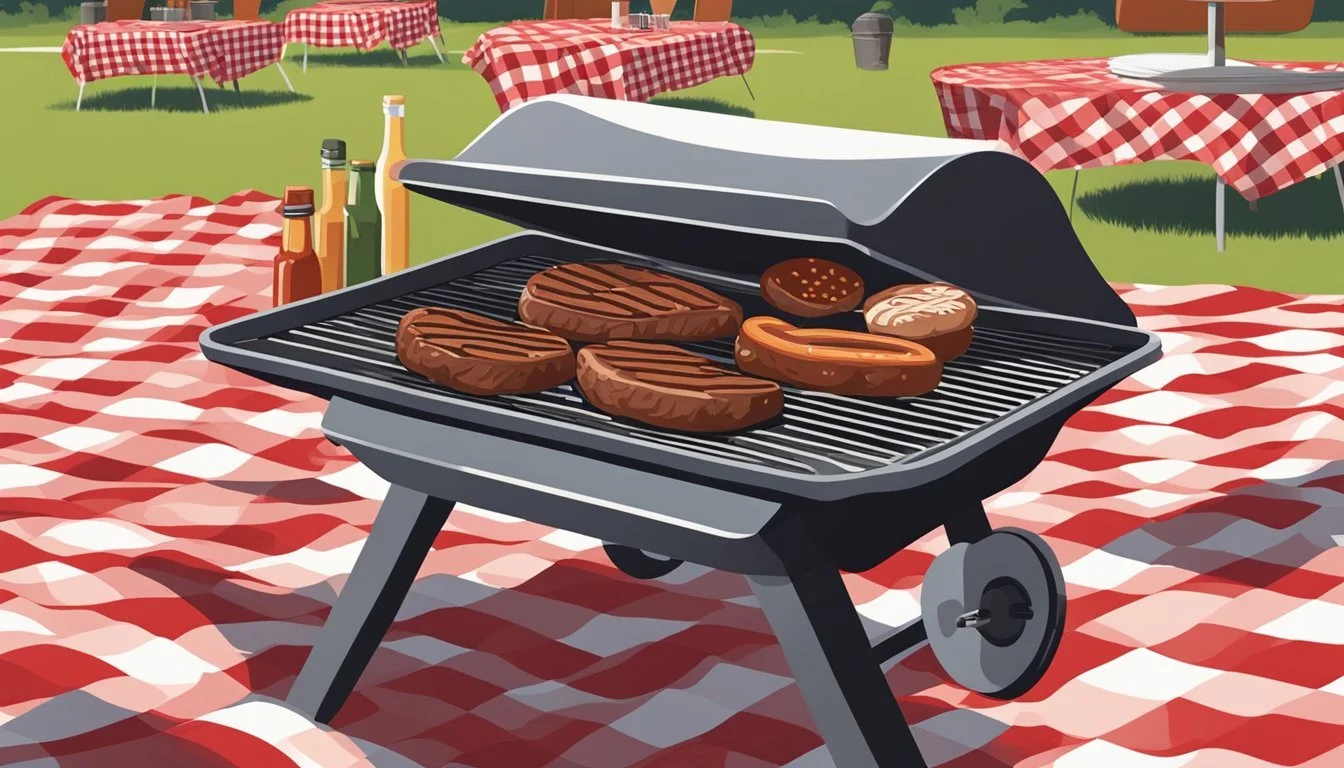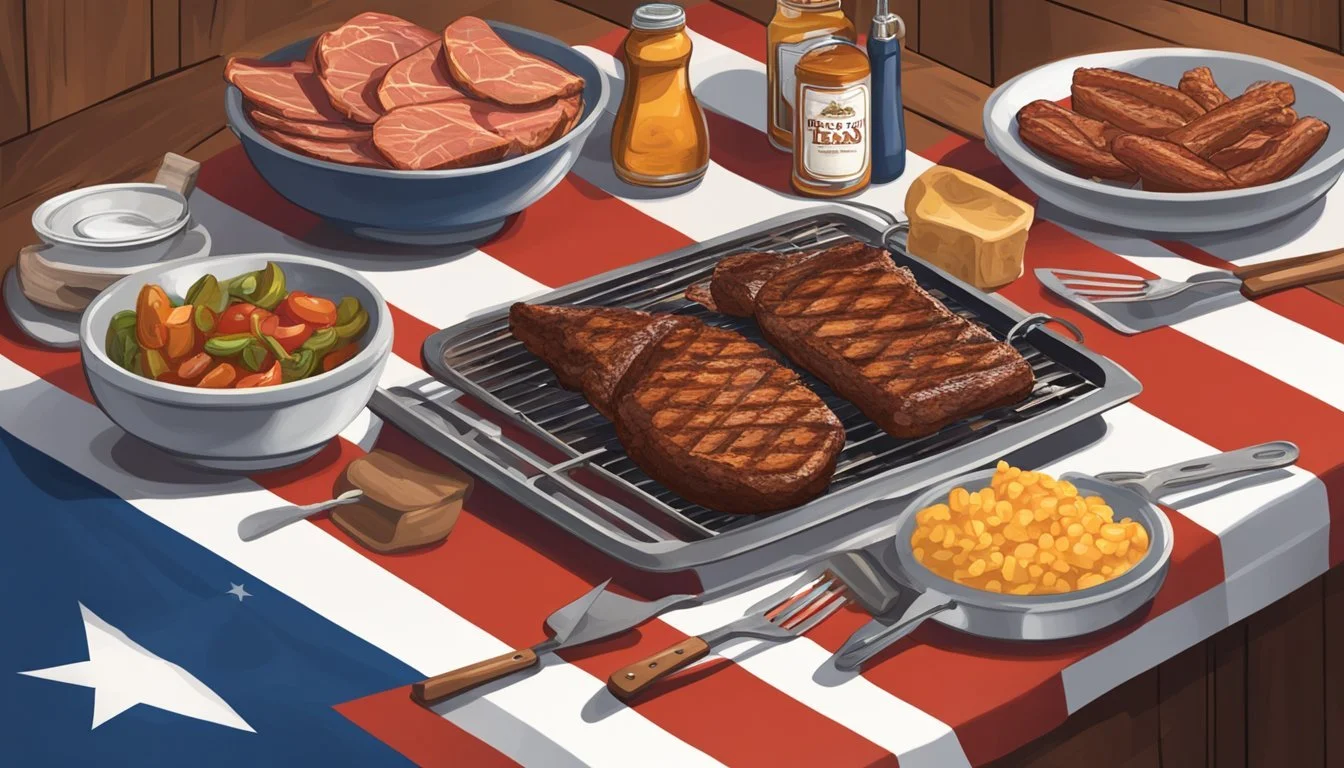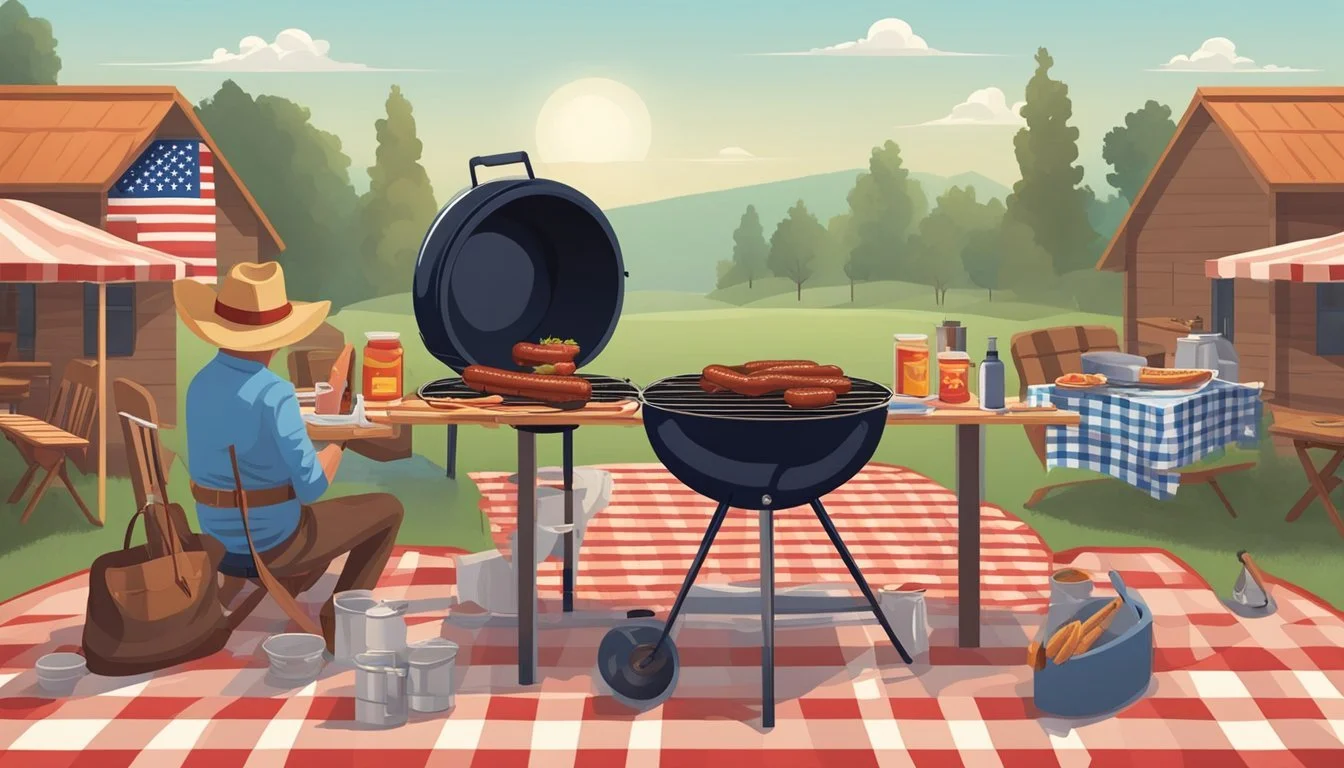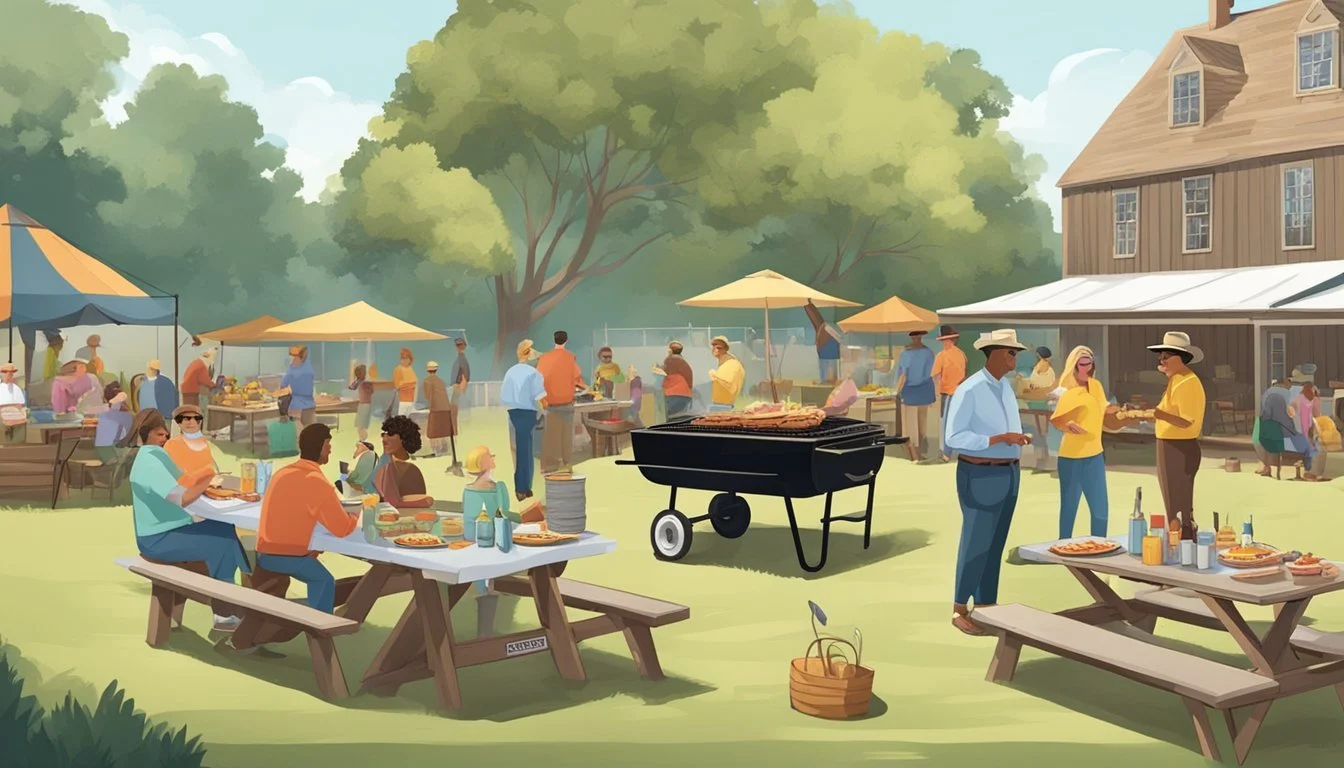How to Host a Texas-Style Backyard BBQ
Your Ultimate Guide
Hosting a Texas-style barbecue is more than just outdoor cooking; it's an experience that embodies the Lone Star State's tradition of meat smoking and savory flavors. The allure of a Texas BBQ lies in its simplicity and commitment to quality, from the choice cuts of brisket to the slow-smoked ribs that fall off the bone. The backyard setting provides an inviting, casual ambiance where guests can bask in the warmth of a Southern evening while the scent of mesquite or oak wood subtly infuses the air with its unmistakable aroma.
A Texas-style BBQ is not only about the food; it's about creating an atmosphere that resonates with the hearty spirit of Texan hospitality. Attention to detail transforms a simple outdoor gathering into an authentic barbecue experience, complete with a selection of seasoned meats and complementary sides like coleslaw, cornbread, and beans. With the grill as the focal point, guests can gather around to watch the magic of slow cooking unfold, partaking in the intimacy and camaraderie that sharing a meal fosters.
Successful execution of a Texas-style backyard barbecue (What wine goes well with barbecue?) hinges on preparation and an understanding of the cooking process. Equip the outdoor space with adequate seating and decor to ensure comfort and visual appeal, and select a variety of meats to cater to differing tastes. Meticulously monitor the temperature and smoke levels to achieve the perfect tenderness and flavor profile expected from a Texas BBQ. These elements together guarantee that the event is memorable, satisfying, and unmistakably Texan at its core.
Planning Your Texas-Style BBQ
The key to a successful Texas-style BBQ lies in careful planning—from the date and guest list to setting up the ideal cooking space with the right equipment.
Selecting the Date and Invitations
One should select a date that accommodates most of the attendees, often weekends or during a celebration such as Father's Day. Once the date is set, creating and sending out invitations can set the tone for the event. For a Texas BBQ-themed get-together, consider using designs that feature rustic or Southern motifs.
Setting Up Your Backyard Space
The backyard should be arranged to maximize guests' comfort and accessibility. Clear space for dining and set up tables with ample seating. One can also create a casual atmosphere by having picnic blankets on the lawn for a potluck style meal. For evening events, ensure adequate lighting for both safety and ambiance.
Outdoor Cooking Equipment Essentials
The showcase of a Texas BBQ is the outdoor cooking setup. One needs a primary grill or smoker—be it a charcoal grill, pellet smoker, electric smoker, or offset smoker—according to preference. Gather all necessary tools and accessories, such as a meat thermometer, tongs, and spatulas. Ensure a stock of fuel like charcoal or wood pellets, and consider a thermometer for maintaining the perfect cooking temperature.
Crafting the Menu
Crafting the menu for a Texas-style backyard BBQ revolves around selecting succulent main dishes, complementary side dishes, a range of beverages including classic cocktails, and considerate options for those with dietary restrictions.
Selecting the Main Dishes
The cornerstone of any Texas BBQ is the meat selection. A traditional menu often features brisket, smoked to perfection over oak or hickory wood. Other favorites include bbq ribs—both pork spare ribs and beef short ribs (What wine goes well with beef short ribs?)—as well as pulled pork. These meats require hours of slow cooking to achieve the right balance of smoke, flavor, and tenderness. Recipes for the rubs and marinades are crucial, with many pitmasters opting for a simple salt and pepper rub for their beef brisket to let the natural flavors shine.
Brisket: Hailed as the king of Texas BBQ, often served sliced with a side of barbecue sauce.
Ribs: Choose between pork or beef ribs, or offer a mix; all slathered with a rich, tangy sauce.
Pulled Pork: Tender and flavorful, pulled pork is a versatile crowd-pleaser.
Choosing Side Dishes
Side dishes play a significant role in complementing the flavors of the BBQ. Beans, potato salad, and slaw are timeless accompaniments. Additionally, Texas caviar, a zesty bean salad, offers a refreshing contrast to the smoky meats.
Beans: Pinto beans stewed with spices and meat trimmings.
Potato Salad: Creamy, mustard-based potato salad is a classic choice.
Slaw: A crunchy, tangy cabbage slaw balances the rich meats.
Texas Caviar: A bean salad with a tangy vinaigrette, bell peppers, and onions.
Beverages and Appetizers
Start with easy appetizers like jalapeño poppers or stuffed mushrooms to whet the appetite. For drinks, offer a mix of cocktails and sodas to cater to all preferences. Signature Texan cocktails might include a classic margarita or a refreshing Texas-style ranch water.
Appetizers: Jalapeño poppers, stuffed mushrooms, and deviled eggs.
Cocktails: Margaritas, ranch water, and sweet tea bourbon.
Sodas: A variety of sodas for those who prefer non-alcoholic drinks.
Vegetarian Options and Accommodations
It's important to accommodate guests with different dietary needs. Vegetarian alternatives can include grilled vegetable skewers or a smoked portobello mushroom in place of the traditional meats. Hearty vegetarian bean dishes and sides like potato salad and slaw are also enjoyable for everyone.
Smoked Portobello Mushrooms: A meaty texture that stands up well to smoking and grilling.
Grilled Vegetable Skewers: A colorful and tasty option featuring bell peppers, onions, and zucchini.
Hearty Bean Dishes: A mainstay that can be prepared vegetarian without sacrificing flavor.
BBQ Techniques and Tips
To host a genuine Texas-style barbecue, one needs to understand the crucial techniques of smoking meat, mastering the grill, and perfecting the use of seasonings and marinades. These elements define the heart of Texas BBQ.
The Art of Smoking Meat
Texas barbecue revolves around the art of smoking meat, especially beef, to achieve the iconic smoky flavor. Smoking requires a wood-burning smoker and a commitment to the low and slow approach. Key elements include:
Choice of Wood: For authentic Texas barbecue, use hickory or oak for a deep, smoky flavor.
Temperature Control: Maintain a consistent temperature between 225-250°F for optimal smoke infusion.
Types of Meat: Brisket and ribs are classics, with brisket requiring a smoke time of up to 1.5 hours per pound.
Mastering the Grill
Grilling is a technique that differs from smoking by using direct heat. For Texas BBQ, the grill is still very much part of the tradition, particularly for certain cuts of meat. Essentials for grilling include:
Grill Type: Use either a standard grill or a pellet grill for better temperature management.
Grill Setup: Set up for indirect heat when necessary to prevent the outside of the meat from cooking too quickly before the inside is done.
Direct Heat: High heat is essential for searing meat and locking in flavors.
Seasoning and Marinades
Seasoning and marinading the meat are integral to the flavor profile of any Texas barbecue. A balance between seasoning and the natural flavors of the meat is crucial.
Basic Rubs: A simple yet effective rub for Texas BBQ consists of salt and black pepper; this is known as the 'Dalmatian rub.'
Dry vs. Wet: Some pitmasters prefer dry rubs for a crusty bark, while others swear by a slather of mustard or oil as a base for their rubs to adhere better.
Marinades: Vinegar, oil, or even beer can be used as a marinade base to tenderize and infuse the meat with flavors.
Incorporating these techniques and tips into your Texas BBQ will elevate your cooking and ensure a delicious, authentic experience for your guests.
Wood Choices and Flavors
Selecting the right wood for smoking is crucial when hosting a Texas-style barbecue. The wood used directly impacts the flavor of the meat, making it an essential element for authentic Texas BBQ.
Types of Wood for Smoking
Mesquite: Known for its potent flavor, mesquite wood is a traditional choice in Texas barbecue. Its intense smoke can overpower, so it's best used with hearty cuts of meat.
Flavor Profile: Strong, earthy
Best for: Beef, particularly brisket
Hickory: Hickory wood offers a robust flavor that is less intense than mesquite but still very distinctive. It's a versatile choice that complements most types of meat well.
Flavor Profile: Rich, bacon-like
Best for: Pork, ribs, and chicken
Oak: A common choice for its availability and balanced flavor, oak is often used as a base wood in Texas BBQ.
Flavor Profile: Medium smoky
Best for: Beef or lamb
Post Oak: A specific variety of oak, post oak imparts a milder smoke flavor and is particularly popular in Central Texas BBQ circles.
Flavor Profile: Mild, slightly sweet
Best for: Brisket and sausage
Pecan: Less intense than hickory, pecan wood gives a fruity note and sweet finish. It burns cooler, making for a gentle smoke.
Flavor Profile: Mild, sweet, nutty
Best for: Poultry and pork
For smoke generation, cooks can choose between wood chips and wood pellets:
Wood Chips: They ignite and smoke quickly, making them ideal for shorter cook times.
Wood Pellets: Compressed sawdust pellets offer a consistent burn rate, suitable for prolonged smoking sessions.
Serving Your BBQ Feast
When hosting a Texas-style backyard BBQ, the manner in which the food is served can greatly enhance the overall dining experience. Ensuring that the tables are arranged for easy access and that the food is kept at safe temperatures are pivotal for guest satisfaction and safety.
Arranging the Food Tables
The food tables should be set up to facilitate smooth flow and easy reach. They ought to be organized with clear sections:
Starters & Salads: Place lighter fare at the beginning.
Main Courses: Feature the BBQ meats prominently in the center.
Sides: Group sides like baked beans and potato salad together.
Desserts: End with a dessert station.
Tables should be stable and covered with themed, easy-to-clean tablecloths. Entertaining essentials like plates, utensils, and napkins can be positioned at both ends to suit guest flow.
Keeping Food at Safe Temperatures
Maintaining safe food temperatures is crucial. Use the following guidelines:
Hot Foods: Keep BBQ meats and sides above 140°F using chafing dishes or warming trays.
Cold Foods: Salads and desserts should be kept below 40°F with coolers or ice trays.
For precise temperature control, utilize meat thermometers for the BBQ meats. Regular checks with thermometers are advisable to ensure food safety throughout the event.
Popular Texas BBQ Styles
Texas BBQ is renowned for its rich flavors and region-specific techniques. It's essential to note that the styles can vary significantly throughout the Lone Star State, from the type of wood used to the preferred cuts of meat.
Understanding Regional Variations
Central Texas Barbecue is characterized by a focus on high-quality smoked meats, often with a simple salt and pepper rub, allowing the flavor of the meat to be the star. They primarily use oak wood for smoking, which imparts a subtle flavor. Expect to see meat like beef ribs and brisket featured prominently.
In East Texas, the style overlaps somewhat with the traditions of southern BBQ states like Tennessee and South Carolina. The meat, frequently pork, is slowly cooked to the point that it falls off the bone, and it's often served with a sweet, tomato-based sauce.
Moving to West Texas, you encounter the "cowboy style" of BBQ, which involves cooking over direct heat, usually from mesquite wood, which gives the meat a bold, smoky flavor.
South Texas is known for its "barbacoa," which has Mexican influences. Traditionally, this involves cooking beef head in a pit. It's known for its tenderness and strong cultural significance.
Barbecue Traditions Beyond Texas
While Texas stands out for its BBQ, regions such as Kansas City, Memphis, and South Carolina are also acclaimed for their barbecue traditions.
Memphis-style barbecue is particularly known for its pork ribs, (What wine goes well with pork ribs?) which can be found "wet" (covered in sauce) or "dry" (with a seasoned rub).
In South Carolina, barbecue often involves a mustard-based sauce, quite distinct from the sauces used in Texas, which vary greatly in sweetness and tang.
These traditions highlight the vast diversity and the rich tapestry of barbecue across the United States, with Texas BBQ remaining a central and beloved style.
BBQ Etiquette and Traditions
When hosting an authentic Texas barbecue, it's essential to embrace the customs that have been cultivated over generations. Texas-barbecue joints are known not only for their succulent meats but also for a distinctive set of traditions that contribute to the overall dining experience.
Preparation and Presentation:
Meat Selection: Opt for high-quality cuts like brisket, ribs, and sausage.
Smoking: Embrace low-and-slow cooking, which could take hours, to impart the signature smokiness.
Slicing: Present the meat by slicing it only when ready to serve to preserve the juices and flavors.
Serving Suggestions:
Buffet Style: Arrange the food buffet-style, allowing guests to help themselves.
Communal Tables: Set up long tables to foster a communal atmosphere.
Sauce On The Side: Offer sauces on the side to respect the smoke-infused flavor of the meat.
Dining Etiquette:
Use of Hands: Encourage the use of hands for foods like ribs for an authentic experience.
No Waste: Encourage guests to take only what they can eat to minimize waste.
Cash Payment: Have cash ready if visiting local barbecue joints, as some may not accept credit cards.
Respect for the Pitmaster:
Patience: Understand that good barbecue takes time and refrain from rushing the pitmaster.
Gratitude: Always show appreciation for the craft and hard work involved in preparing Texas barbecue.
Enhancing the Ambiance
A Texas-style backyard BBQ is as much about the atmosphere as it is about the food. A host can transform a simple get-together into an authentic Texas experience with the right ambiance.
Music and Entertainment
Carefully selected music sets the tone for a Texas-style BBQ. A playlist peppered with country classics and southern rock favorites can elevate the mood and immerse guests in the theme. One might consider artists like Jason Mraz for a modern twist or stick to traditional country tunes that get boots tapping. Live music, if possible, can truly enhance the atmosphere, making guests feel as though they've stepped into a Texan backyard.
An entertainment lineup featuring games relevant to Texas culture can also serve as a conversation starter and a way to engage guests of all ages. It's crucial to remember that the music and entertainment should complement the gathering, maintaining a balance that allows for both dining and socializing.
Safety and Clean-Up
When hosting a Texas-style backyard barbecue, the host must prioritize safety measures to prevent accidents and have efficient clean-up strategies in place to deal with post-event clutter.
Ensuring a Safe BBQ Experience
Grilling Area: Ensure that the grill is placed on a stable, fireproof surface, away from structures and flammable materials. Children and pets must be supervised to keep them at a safe distance.
Fire Safety: Always have a fire extinguisher or a bucket of sand on hand for emergencies. Check that the extinguisher is readily accessible and that everyone knows how to operate it.
Food Safety: Keep raw meat separate from other foods and use a food thermometer to ensure meats reach safe internal temperatures. Keep perishable items in coolers with ice to prevent bacterial growth.
Post-BBQ Clean-Up Strategies
Disposal Stations: Set up clearly marked trash and recycling stations to make waste disposal convenient for guests and streamline post-party clean-up.
Immediate Action: Promptly address spills and stains on outdoor furniture using appropriate cleaning agents to avoid permanent damage.
Grill Maintenance: After the barbecue cools down, clean the grill grates with a wire brush. Regular cleaning prevents buildup and ensures the grill is ready for next use.






